2006 SUBARU IMPREZA lock
[x] Cancel search: lockPage 30 of 365
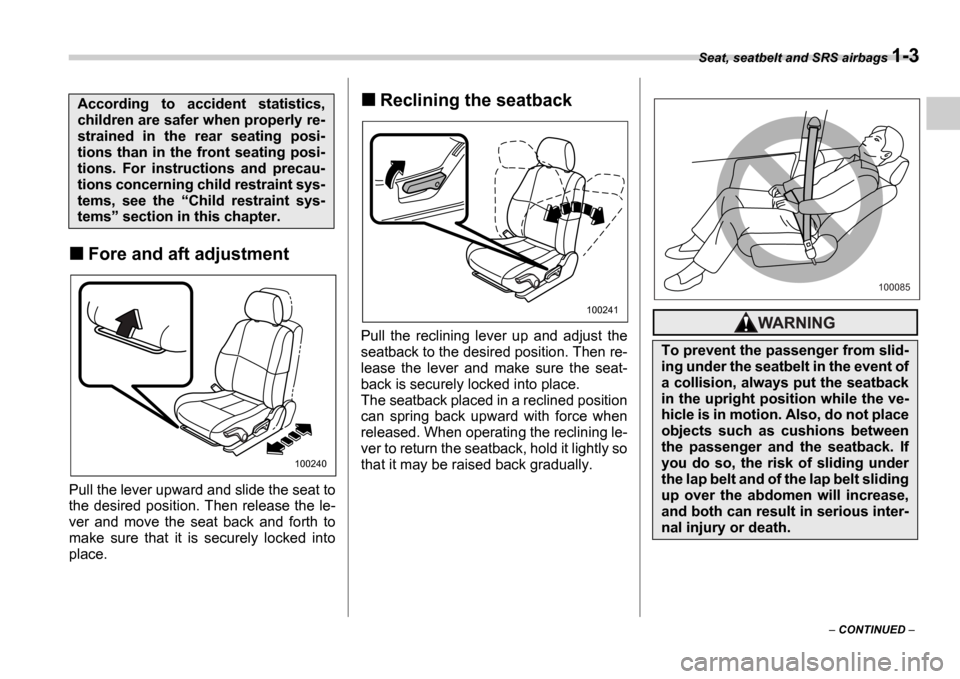
Seat, seatbelt and SRS airbags 1-3
CONTINUED
Fore and aft adjustment
Pull the lever upward and slide the seat to
the desired position. Then release the le-
ver and move the seat back and forth to
make sure that it is securely locked into
place.
Reclining the seatback
Pull the reclining lever up and adjust the
seatback to the desired position. Then re-
lease the lever and make sure the seat-
back is securely locked into place.
The seatback placed in a reclined position
can spring back upward with force when
released. When operating the reclining le-
ver to return the seatback, hold it lightly so
that it may be raised back gradually.
According to accident statistics,
children are safer when properly re-
strained in the rear seating posi-
tions than in the front seating posi-
tions. For instructions and precau-
tions concerning child restraint sys-
tems, see the Child restraint sys-
tems section in this chapter.
100240
100241
To prevent the passenger from slid-
ing under the seatbelt in the event of
a collision, always put the seatback
in the upright position while the ve-
hicle is in motion. Also, do not place
objects such as cushions between
the passenger and the seatback. If
you do so, the risk of sliding under
the lap belt and of the lap belt sliding
up over the abdomen will increase,
and both can result in serious inter-
nal injury or death.
100085
Page 36 of 365
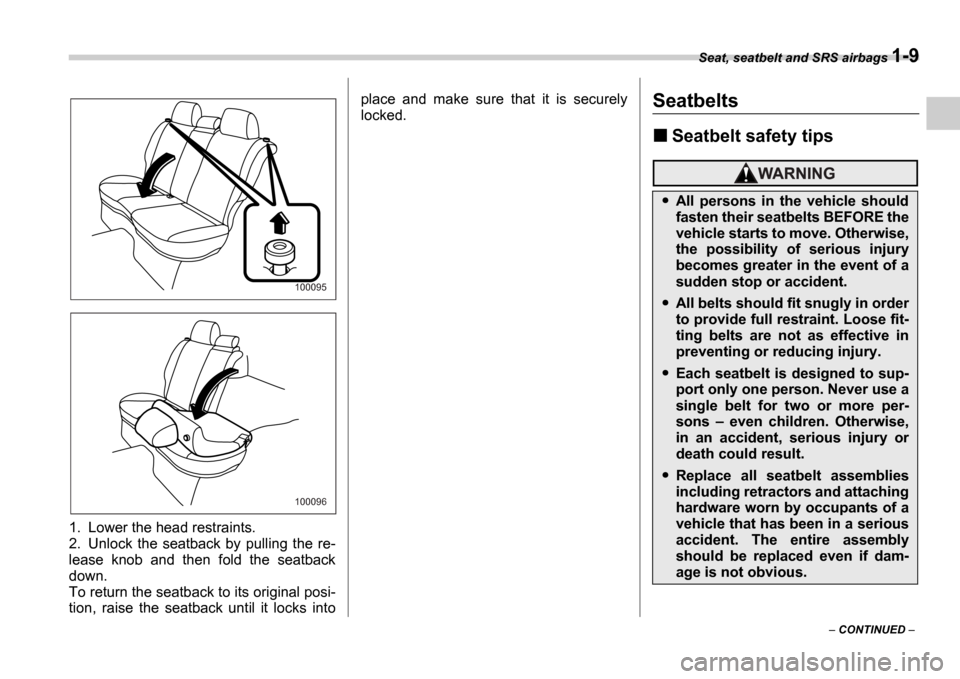
Seat, seatbelt and SRS airbags 1-9
CONTINUED
1. Lower the head restraints.
2. Unlock the seatback by pulling the re-
lease knob and then fold the seatback
down.
To return the seatback to its original posi-
tion, raise the seatback until it locks into place and make sure that it is securely
locked.
Seatbelts
Seatbelt safety tips
100095
100096
All persons in the vehicle should
fasten their seatbelts BEFORE the
vehicle starts to move. Otherwise,
the possibility of serious injury
becomes greater in the event of a
sudden stop or accident.
All belts should fit snugly in order
to provide full restraint. Loose fit-
ting belts are not as effective in
preventing or reducing injury.
Each seatbelt is designed to sup-
port only one person. Never use a
single belt for two or more per-
sons
even children. Otherwise,
in an accident, serious injury or
death could result.
Replace all seatbelt assemblies
including retractors and attaching
hardware worn by occupants of a
vehicle that has been in a serious
accident. The entire assembly
should be replaced even if dam-
age is not obvious.
Page 38 of 365
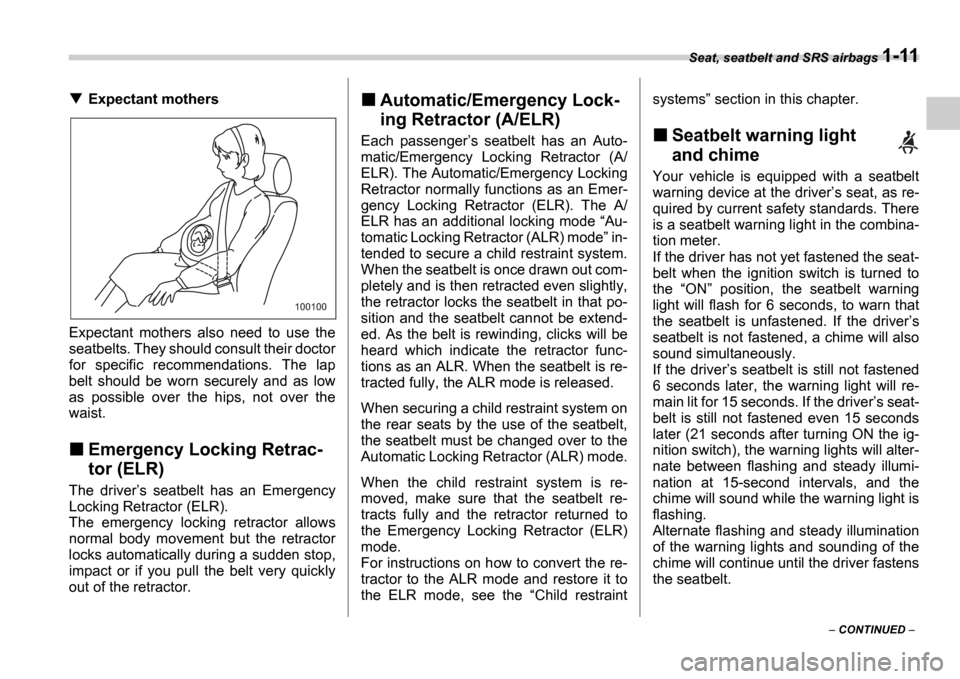
Seat, seatbelt and SRS airbags 1-11
CONTINUED
Expectant mothers
Expectant mothers also need to use the
seatbelts. They should consult their doctor
for specific recommendations. The lap
belt should be worn securely and as low
as possible over the hips, not over the
waist.
Emergency Locking Retrac-
tor (ELR)
The driver s seatbelt has an Emergency
Locking Retractor (ELR).
The emergency locking retractor allows
normal body movement but the retractor
locks automatically during a sudden stop,
impact or if you pull the belt very quickly
out of the retractor.
Automatic/Emergency Lock-
ing Retractor (A/ELR)
Each passenger s seatbelt has an Auto-
matic/Emergency Locking Retractor (A/
ELR). The Automatic/Emergency Locking
Retractor normally functions as an Emer-
gency Locking Retractor (ELR). The A/
ELR has an additional locking mode Au-
tomatic Locking Retractor (ALR) mode in-
tended to secure a child restraint system.
When the seatbelt is once drawn out com-
pletely and is then retracted even slightly,
the retractor locks the seatbelt in that po-
sition and the seatbelt cannot be extend-
ed. As the belt is rewinding, clicks will be
heard which indicate the retractor func-
tions as an ALR. When the seatbelt is re-
tracted fully, the ALR mode is released.
When securing a child restraint system on
the rear seats by the use of the seatbelt,
the seatbelt must be changed over to the
Automatic Locking Retractor (ALR) mode.
When the child restraint system is re-
moved, make sure that the seatbelt re-
tracts fully and the retractor returned to
the Emergency Locking Retractor (ELR)
mode.
For instructions on how to convert the re-
tractor to the ALR mode and restore it to
the ELR mode, see the Child restraint systems
section in this chapter.Seatbelt warning light
and chime
Your vehicle is equipped with a seatbelt
warning device at the driver s seat, as re-
quired by current safety standards. There
is a seatbelt warning light in the combina-
tion meter.
If the driver has not yet fastened the seat-
belt when the ignition switch is turned to
the ON position, the seatbelt warning
light will flash for 6 seconds, to warn that
the seatbelt is unfastened. If the driver s
seatbelt is not fastened, a chime will also
sound simultaneously.
If the driver s seatbelt is still not fastened
6 seconds later, the warning light will re-
main lit for 15 seconds. If the driver s seat-
belt is still not fastened even 15 seconds
later (21 seconds after turning ON the ig-
nition switch), the warning lights will alter-
nate between flashing and steady illumi-
nation at 15-second intervals, and the
chime will sound while the warning light is
flashing.
Alternate flashing and steady illumination
of the warning lights and sounding of the
chime will continue until the driver fastens
the seatbelt.
100100
Page 40 of 365
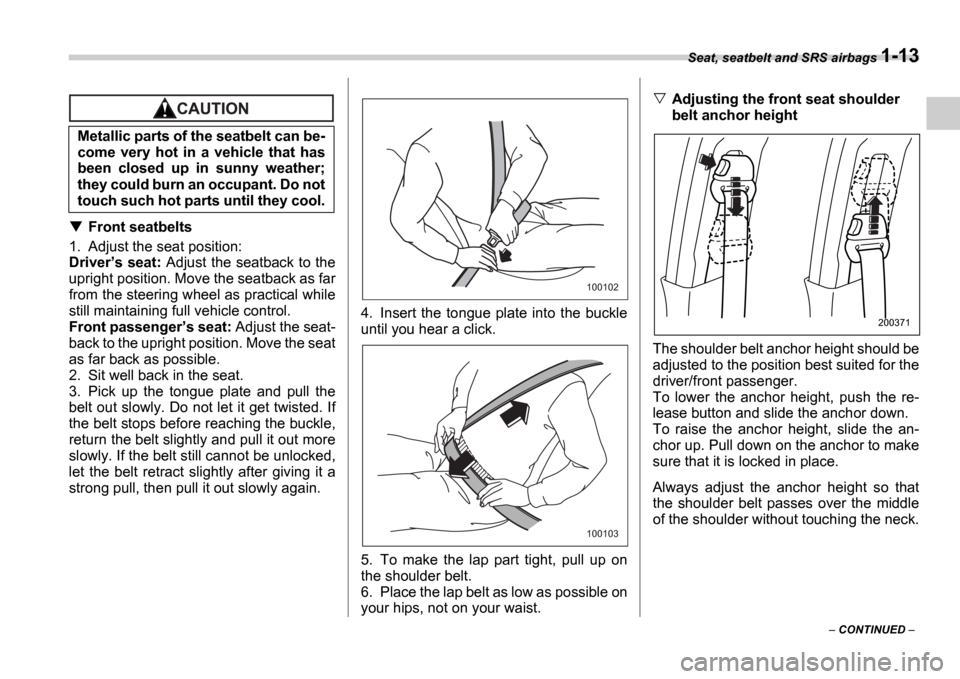
Seat, seatbelt and SRS airbags 1-13
CONTINUED
Front seatbelts
1. Adjust the seat position:
Driver s seat: Adjust the seatback to the
upright position. Move the seatback as far
from the steering wheel as practical while
still maintaining full vehicle control.
Front passenger s seat: Adjust the seat-
back to the upright position. Move the seat
as far back as possible.
2. Sit well back in the seat.
3. Pick up the tongue plate and pull the
belt out slowly. Do not let it get twisted. If
the belt stops before reaching the buckle,
return the belt slightly and pull it out more
slowly. If the belt still cannot be unlocked,
let the belt retract slightly after giving it a
strong pull, then pull it out slowly again. 4. Insert the tongue plate into the buckle
until you hear a click.
5. To make the lap part tight, pull up on
the shoulder belt.
6. Place the lap belt as low as possible on
your hips, not on your waist.
Adjusting the front seat shoulder
belt anchor height
The shoulder belt anchor height should be
adjusted to the position best suited for the
driver/front passenger.
To lower the anchor height, push the re-
lease button and slide the anchor down.
To raise the anchor height, slide the an-
chor up. Pull down on the anchor to make
sure that it is locked in place.
Always adjust the anchor height so that
the shoulder belt passes over the middle
of the shoulder without touching the neck.
Metallic parts of the seatbelt can be-
come very hot in a vehicle that has
been closed up in sunny weather;
they could burn an occupant. Do not
touch such hot parts until they cool.
100102
100103
200371
Page 41 of 365
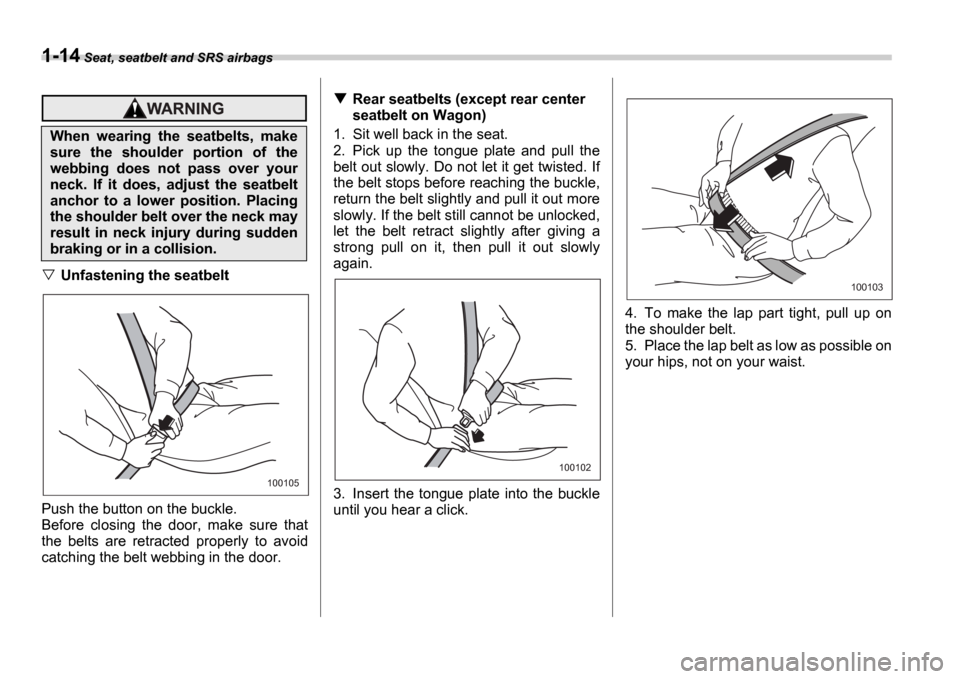
1-14 Seat, seatbelt and SRS airbags
Unfastening the seatbelt
Push the button on the buckle.
Before closing the door, make sure that
the belts are retracted properly to avoid
catching the belt webbing in the door.
Rear seatbelts (except rear center
seatbelt on Wagon)
1. Sit well back in the seat.
2. Pick up the tongue plate and pull the
belt out slowly. Do not let it get twisted. If
the belt stops before reaching the buckle,
return the belt slightly and pull it out more
slowly. If the belt still cannot be unlocked,
let the belt retract slightly after giving a
strong pull on it, then pull it out slowly
again.
3. Insert the tongue plate into the buckle
until you hear a click. 4. To make the lap part tight, pull up on
the shoulder belt.
5. Place the lap belt as low as possible on
your hips, not on your waist.
When wearing the seatbelts, make
sure the shoulder portion of the
webbing does not pass over your
neck. If it does, adjust the seatbelt
anchor to a lower position. Placing
the shoulder belt over the neck may
result in neck injury during sudden
braking or in a collision.
100105
100102
100103
Page 42 of 365
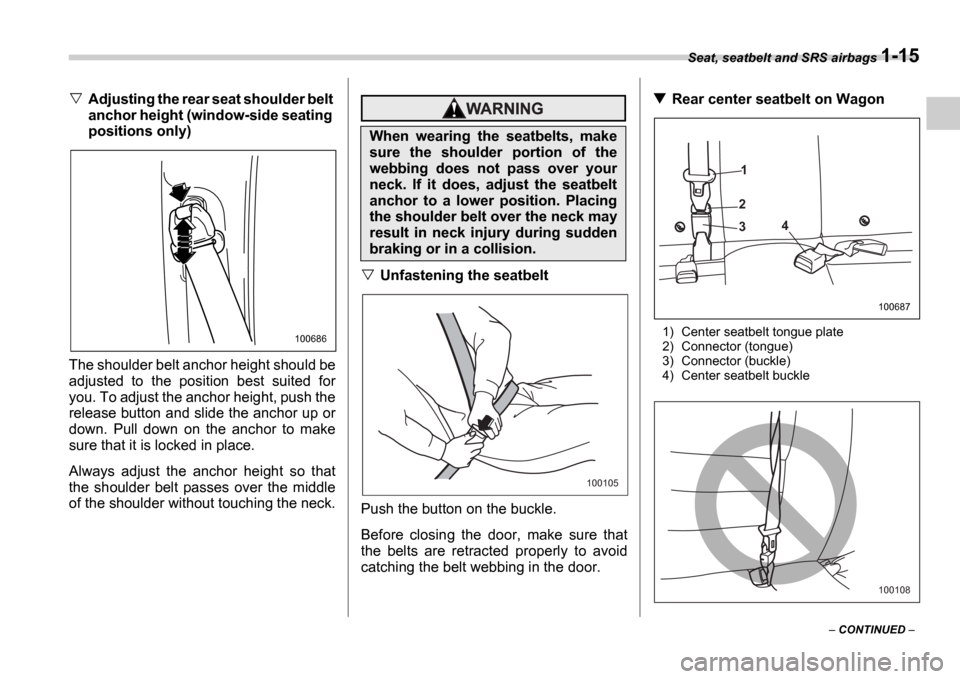
Seat, seatbelt and SRS airbags 1-15
CONTINUED
Adjusting the rear seat shoulder belt
anchor height (window-side seating
positions only)
The shoulder belt anchor height should be
adjusted to the position best suited for
you. To adjust the anchor height, push the
release button and slide the anchor up or
down. Pull down on the anchor to make
sure that it is locked in place.
Always adjust the anchor height so that
the shoulder belt passes over the middle
of the shoulder without touching the neck.
Unfastening the seatbelt
Push the button on the buckle.
Before closing the door, make sure that
the belts are retracted properly to avoid
catching the belt webbing in the door.
Rear center seatbelt on Wagon
1) Center seatbelt tongue plate
2) Connector (tongue)
3) Connector (buckle)
4) Center seatbelt buckle100686
When wearing the seatbelts, make
sure the shoulder portion of the
webbing does not pass over your
neck. If it does, adjust the seatbelt
anchor to a lower position. Placing
the shoulder belt over the neck may
result in neck injury during sudden
braking or in a collision.
100105
3 4
1
2
100687
100108
Page 44 of 365
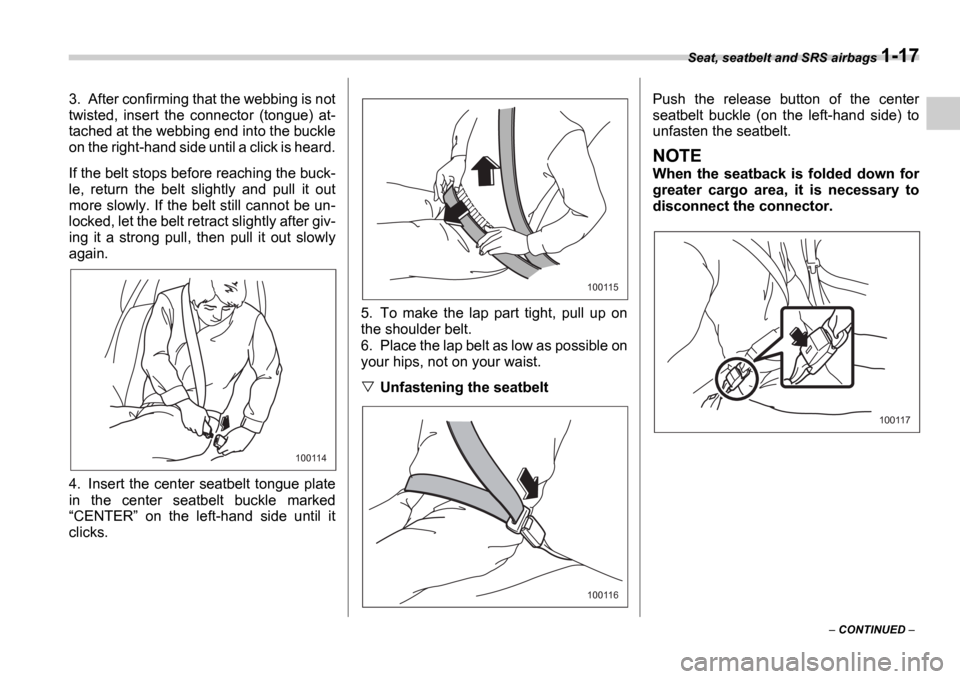
Seat, seatbelt and SRS airbags 1-17
CONTINUED
3. After confirming that the webbing is not
twisted, insert the connector (tongue) at-
tached at the webbing end into the buckle
on the right-hand side until a click is heard.
If the belt stops before reaching the buck-
le, return the belt slightly and pull it out
more slowly. If the belt still cannot be un-
locked, let the belt retract slightly after giv-
ing it a strong pull, then pull it out slowly
again.
4. Insert the center seatbelt tongue plate
in the center seatbelt buckle marked
CENTER on the left-hand side until it
clicks. 5. To make the lap part tight, pull up on
the shoulder belt.
6. Place the lap belt as low as possible on
your hips, not on your waist.
Unfastening the seatbeltPush the release button of the center
seatbelt buckle (on the left-hand side) to
unfasten the seatbelt.
NOTE
When the seatback is folded down for
greater cargo area, it is necessary to
disconnect the connector.
100114
100115
100116
100117
Page 46 of 365

Seat, seatbelt and SRS airbags 1-19
Seatbelt extender
If the front seatbelts are not long enough
to permit the tongue plate to engage with
the seatbelt buckle, an optional seatbelt
extender is available from your SUBARU
dealer. When ordering an extender, only
order one particularly designed for your
vehicle. Several different types of extend-
ers are available to match various variet-
ies of front seatbelt designs. See your
SUBARU dealer for assistance.
The extender adds approximately 8 inch-
es (200 mm) of length and it can be used
for either the driver or front passenger
seating position.
For the safety of others, the extender
should be removed after each use, espe-
cially if the next person using the seatbelt
does not need one.
Note that leaving the seatbelt extender s
tongue plate engaged with the seatbelt
buckle may prevent the Subaru advanced
front airbag system from functioning cor-
rectly or cause the system to fail.
NOTE
When the seatbelt extender is used by a pregnant passenger, consult a doctor
to get approval in advance.
To connect the extender to the seatbelt,
insert the tongue plate into the seatbelt
buckle so that the
PRESS signs on the
buckle-release buttons of the extender
and the seatbelt are both facing outward
as shown in the diagram. You will hear a
click when the tongue plate locks into the
buckle.
When releasing the seatbelt, press on the
buckle-release button on the extender, not
on the seatbelt. This helps to prevent
damage to the vehicle interior and extend-
er itself.
Be sure to observe the following
when using the seatbelt extender.
Failure to follow these instructions
and warnings could reduce the ef-
fectiveness of the seatbelt and re-
sult in more serious injury in the
event of a collision.
Never use the extender when the
belt itself is long enough to permit
it to be buckled properly. If remov-
al of heavy clothing is all that is
needed to permit the seatbelt to
be buckled properly, remove the
heavy clothing and do not use the
extender.
Do not use the extender if the
buckle of the extender rests over
the abdomen.
Do not let someone else use the
extender. Use of an extender
when it is not needed could re-
duce the effectiveness of the seat-
belt and result in more serious in-
jury in the event of a collision.
Use the extender only for the front
seatbelts and only for the model
for which it was originally provid-
ed. Never use the extender for the
rear seatbelts or for a different
model.
100605